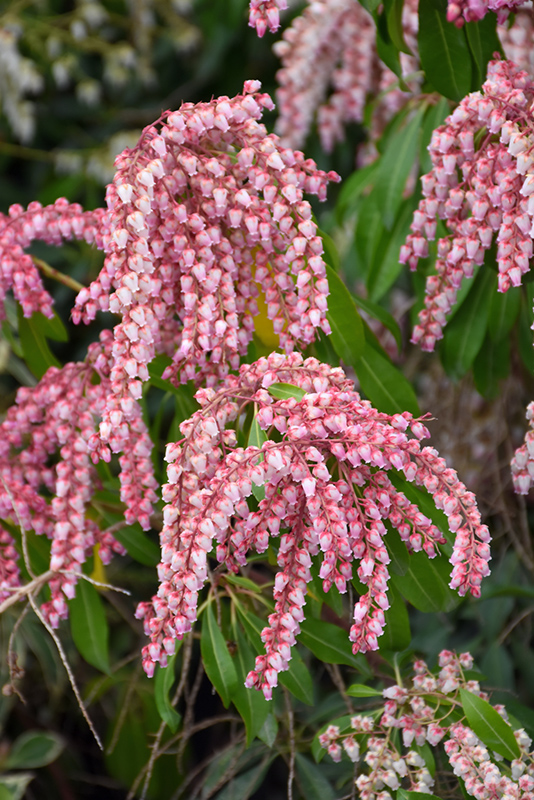Pieris, Valley Rose Pieris japonica 'Valley Rose' Height: 5 feet Spread: 5 feet
Sunlight:
Hardiness Zone: 5b Other Names: Japanese Andromeda Description: A highly ornamental broadleaf evergreen shrub, prized for its very delicate and showy chains of small pink bell-shaped flowers and very colorful emerging foliage; performs best in moist, acidic soils; water regularly in the heat Ornamental Features Pieris, Valley Rose features dainty chains of rose bell-shaped flowers hanging below the branches in early spring. It has attractive dark green evergreen foliage which emerges burgundy in spring. The glossy narrow leaves are highly ornamental and remain dark green throughout the winter. Landscape Attributes Pieris, Valley Rose is a dense multi-stemmed evergreen shrub with a more or less rounded form. Its average texture blends into the landscape, but can be balanced by one or two finer or coarser trees or shrubs for an effective composition. This shrub will require occasional maintenance and upkeep, and should only be pruned after flowering to avoid removing any of the current season's flowers. Deer don't particularly care for this plant and will usually leave it alone in favor of tastier treats. It has no significant negative characteristics. Pieris, Valley Rose is recommended for the following landscape applications; Planting & Growing Pieris, Valley Rose will grow to be about 5 feet tall at maturity, with a spread of 5 feet. It tends to be a little leggy, with a typical clearance of 1 foot from the ground, and is suitable for planting under power lines. It grows at a slow rate, and under ideal conditions can be expected to live for 40 years or more. This shrub does best in partial shade to shade. It does best in average to evenly moist conditions, but will not tolerate standing water. This plant should be periodically fertilized throughout the active growing season with a specially-formulated acidic fertilizer. It is not particular as to soil type, but has a definite preference for acidic soils. It is somewhat tolerant of urban pollution, and will benefit from being planted in a relatively sheltered location. Consider applying a thick mulch around the root zone in winter to protect it in exposed locations or colder microclimates. This is a selected variety of a species not originally from North America, and parts of it are known to be toxic to humans and animals, so care should be exercised in planting it around children and pets. Special Attributes Evergreens need to be watered during the winter. Our desert climate especially in late winter to early spring evergreens can suffer during next growing season. An easy way to remember check for dryness on the holidays Halloween, Thanksgiving, New Year's Day, Valentines Day & Easter.![]()
![]()
![]()
![]()
![]()
![]()
![]()
![]()
![]()
![]()
![]()
![]()
![]()

